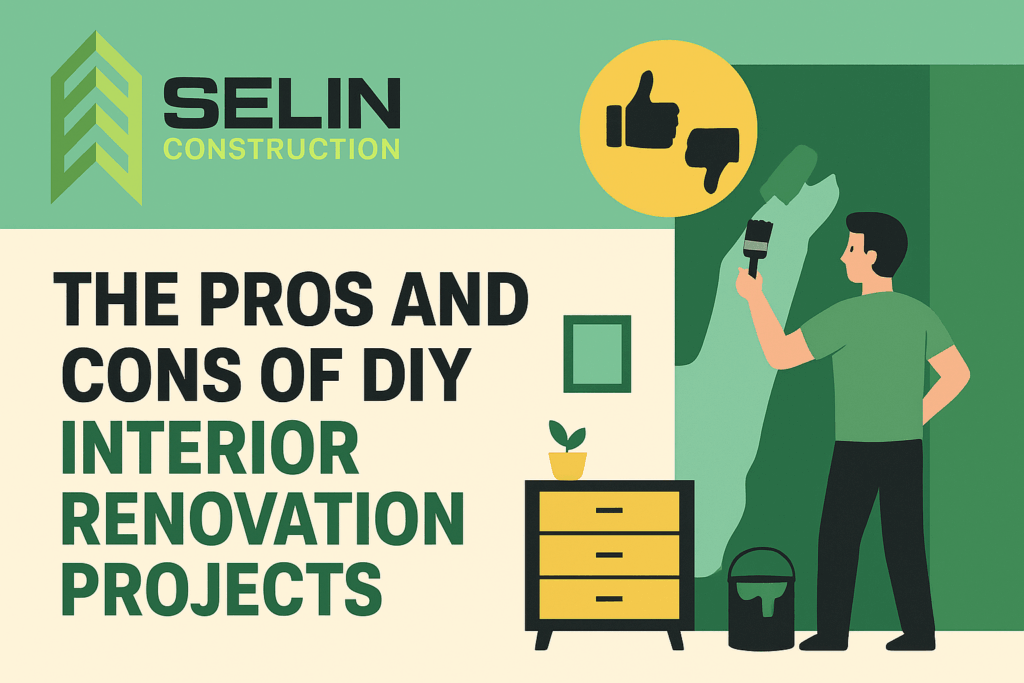|
Getting your Trinity Audio player ready...
|
DIY interior renovation offers homeowners huge savings on labor costs, creative control, the flexibility to work at their own pace, and a rewarding sense of accomplishment. However, if you have no prior experience, DIY might end up costing you more. The cons include significant time investment, the potential for cost overruns, the need for special tools and skills, potential safety risks, and the risks of costly mistakes that might require hiring a professional to fix, eating up all your savings. Building code violations are possible in a DIY project. Weighing your skills, time, and the complexity of the project is crucial for a successful outcome.
DIY Dreams or DIY Disasters: Weighing the Ups and Downs of Interior Home Renovation
Are you excited to tackle the ambitious DIY bathroom remodel in your new fixer-upper home? DIY interior projects offer significant cost savings and can bring a sense of pride and accomplishment. But if you’re unskilled, the toll of home renovation can impact your well-being, and you may feel stressed out soon by the complexity and the potential for errors. Your vision for a spa-like sanctuary can quickly devolve into a chaotic construction zone, filled with unexpected plumbing issues, DIY missteps, and the stark reality of living in a perpetual building site. It is important to have the skills, experience, and realistic expectations about your project before embarking on this challenging journey.
| Fast fact 62% of Americans say that the top reason for attempting a DIY project is to save money, while increasing the future resale value of their home. |
Is DIY renovation right for you? Here are the benefits and the major pitfalls of DIY interior renovation.
Pros – Cost Savings
Labor costs are a significant portion of a renovation’s budget. You can control your project’s budget, spending more on high-quality fixtures and finishes due to reduced labor costs.
Pros – Creative Control
With DIY, you have total autonomy over the designs, timeline, and the decisions made during the project. DIY enables you to pick any color, materials, and design details, without any compromise, your project reflecting your authentic style.
Pros – Flexible Schedule
Doing your own home renovations allows you to work at your own pace, on your own schedule, at any time that suits you best, fitting the project around your life.
Pros – Sense of Accomplishment
You gain new skills with DIY projects and get a deeper understanding of the home improvement processes. Successful completion can bring immense personal satisfaction and a sense of pride, building your confidence for future projects.
| Did you know? The Harvard Joint Center for Housing Studies (JCHS) projects steady growth in home renovation spending, estimating the market growth of $30 billion in 2025, or 6.4%, to $509 billion. |
Cons – Safety Risks
It’s a major concern in DIY projects. Tasks involving electrical work, structural changes, and the use of sharp and unfamiliar tools can be dangerous and pose serious safety risks, especially for untrained DIYers.
Cons – Significant Time Investment
Projects often take much longer than anticipated, as you are learning as you go. The time commitment involves not just the work, but also learning the skills with tutorials and materials shopping, which can be a bit frustrating as the projects often prove to be more technical and difficult than anticipated.
Cons – Cost Overruns
Mistakes can be costly, and with DIY, you stand the risk of cost overruns. The hidden costs often mount, revolving around the need for necessary permits and more tools or experimenting with materials. You might end up hiring a professional to fix your blunders.
Cons – Requirement of Tools and Skills
Some projects require specialized tools and expertise that most homeowners don’t possess, making it safer and more effective to hire a professional.
Cons – Potential for Building Codes Violations
If you are inexperienced, DIY work can easily lead to building code violations, such as unpermitted work, faulty electrical and plumbing installations, incorrect venting, and a lack of safety features like smoke alarms or proper handrails, resulting in hefty fines, expensive corrections, or even stop-work orders.
| Interesting fact An estimated 75% of homeowners attempt DIY projects. 80% people attempting DIY projects make mistakes, and 45% of DIYers report that they have completely butchered a DIY project. |
Conclusion
While DIY interior renovation appears to be cost-effective, offering you more creative freedom and a flexible work schedule, a lack of skills and experience may end up costing you more in the long run. You may have total control over their project’s budget and timeline, but DIY involves significant safety risks and requires a serious time commitment. Mistakes can prove to be very costly, requiring professional assistance. It is essential to understand the importance of understanding and adhering to building codes before beginning a DIY project.
FAQs
What is the ROI for an interior home renovation project?
According to the NAR interior remodeling report, homeowners recoup 100% of their investment from hardwood floor refinishing, new wood flooring (118%), while insulation upgrades provide 100% ROI.
What are the home renovation trends for 2025?
Flooring, cosmetic upgrades, and new wallpaper or paint are the most common home improvement projects homeowners plan to complete in 2025.
What are the most common yet hardest rooms to renovate?
Kitchens and bathrooms are the most common, the hardest, and the most rewarding interior renovations to boost home value, style, and comfort.


